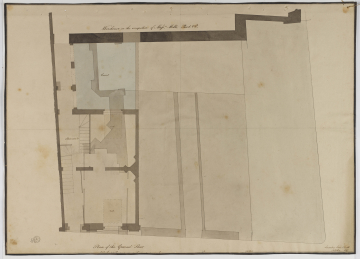
Browse
Reference number
Purpose
Aspect
Scale
Inscribed
Signed and dated
- Lincolns Inn Fields / October 1817
Medium and dimensions
Hand
Notes
SM 48/1/2, SM 48/1/47, SM 48/2/32 and SM 48/1/53 are the earliest surviving dated drawings for the National Debt Redemption Office. The drawing shown here gives the whole of the site in outline with only the merchant's house detailed.
The plan form suggests that SM 48/1/2 may be a survey of the first floor of the Mello, Pead & Co. building. Ground floor plans (SM 48/1/47 and SM 48/1/53) show the proposals for the new building and vary only with the changes made a day later by Soane to the messengers' room and the addition of a lobby and an external stair (bottom right-hand side).
The first of many alternative and variant front elevations, SM 48/1/53 (design A) is six bays wide with the addition of a narrow, almost windowless bay on the left that provides a minor entrance.
The plan of the front wall corresponds with SM 48/1/47. Four storeys high with round-arched windows (except for flanking pedimented windows on the first floor and the square attic windows) the two centre bays of the four-bay attic storey with those of the second floor are recessed. The ground floor has rock-faced rustication, the first floor banded rustication with the four centre windows separated by a motif repeated three times that might be described as a 'spinning top'. The earliest use of this unconventional detail was in Soane's Royal Academy student design for a Triumphal Bridge, 1776 and it occurs again in some of his designs for the Bank of England. Soane also makes use of panel pilasters crowned with antefixae that have (rough pencil) amendments.
Level
Sir John Soane's collection includes some 30,000 architectural, design and topographical drawings which is a very important resource for scholars worldwide. His was the first architect’s collection to attempt to preserve the best in design for the architectural profession in the future, and it did so by assembling as exemplars surviving drawings by great Renaissance masters and by the leading architects in Britain in the 17th and 18th centuries and his near contemporaries such as Sir William Chambers, Robert Adam and George Dance the Younger. These drawings sit side by side with 9,000 drawings in Soane’s own hand or those of the pupils in his office, covering his early work as a student, his time in Italy and the drawings produced in the course of his architectural practice from 1780 until the 1830s.
Browse (via the vertical menu to the left) and search results for Drawings include a mixture of Concise catalogue records – drawn from an outline list of the collection – and fuller records where drawings have been catalogued in more detail (an ongoing process).

